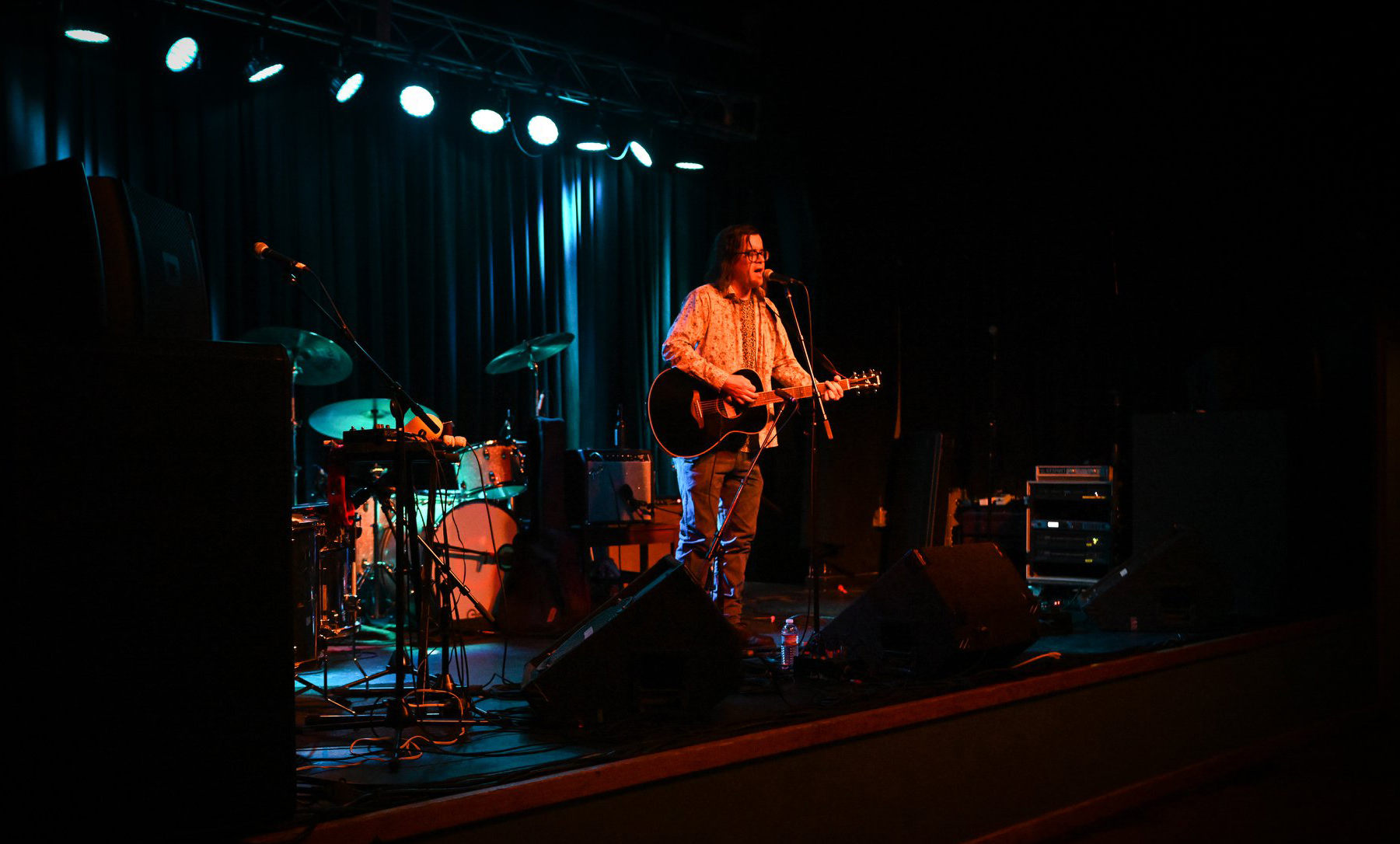Pandemic Hits Arts Economy From Many Directions
Posted on May 26, 2020
Musician Clark Blomquist set up a Facebook Live show as an alternative means to perform during the COVID-19 pandemic. “With a streaming show, you have to use your imagination,” he said. “It doesn’t replace a live audience, but it’s better than nothing.”
For years, singer, guitarist and drummer Clark Blomquist has played at least a couple of gigs a week at local music venues, filling in with shifts at two Carrboro restaurants.
But in mid-March, as stay-at-home directives began in the wake of the COVID-19 pandemic, clubs began canceling shows. Restaurants moved to takeout only and canceled his shifts. Initially willing to “stick at home and see how it goes,” Blomquist said, “it seems like it’s gotten worse and worse.”
COVID-19 delivered a double-whammy to artists and performers. Galleries and theaters went dark, wiping out income from artwork sales, concerts and shows. And restaurants furloughed or laid off wait staff and bartenders, depriving those in the cultural arts income from their second jobs.
Katie Murray, director of the Orange County Arts Commission, called the situation “devastating.”
Orange County has about 4,000 gig workers in the arts community, she said. While restrictions have been relaxed during the pandemic to allow contract workers and the self-employed to apply for unemployment benefits, most are denied benefits because they can’t verify sufficient regular income.
“They can’t get income from their art, they don’t have income from their side jobs, they can’t get unemployment benefits,” Murray said. “They’re in a world of hurt.”
Luna Lee Ray paints in mixed-media acrylics and has taught at the ArtsCenter in Carrboro for 20 years. She is the curator at Frank Gallery in University Place mall and exhibits on the Orange County Studio Tour, among other venues. “The arts are my life,” she said.
Then the ArtsCenter canceled classes, Frank closed its doors, and the studio tour might go online, if it happens at all. She has set up an online gallery at Frank, and the gallery manager will book appointments for potential buyers who want to see a piece in person. While an online presence is important for keeping art-lovers engaged, “it’s like listening to music on the radio versus at a concert,” she said.
Artists and performers have tried to find alternative ways to showcase their talents, but it’s hard to do virtually. Gauging the quality of art is difficult online, and the quality of live broadcasts for local musicians is less than ideal.
Ali Farahnakian ’90, owner of The PIT comedy theater on West Franklin Street, has streamed improv shows via Zoom to try to keep his audiences engaged, but it’s not the same atmosphere as a live show. The schedule for Cat’s Cradle, for decades a mecca for bands on the way up, is now a long list of postponements and cancellations. It’s the same at Local 506.
“You don’t have the arts without audiences,” Murray said. “It’s a pretty scary time.”
Blomquist set up a Facebook Live show. Though he couldn’t see his audience as he performed, much less feed off their energy, he was aware that people were listening.
“It didn’t feel like I was playing to the cat,” he said. “With a streaming show, you have to use your imagination. It doesn’t replace a live audience, but it’s better than nothing.”
The Arts Commission has set up a relief fund for county arts workers and arts organizations. Both Blomquist and Ray are grateful recipients. Because government moves slowly, Murray raised the money through private donations to a GoFundMe page. About 140 individuals and five community organizations donated a total of $41,000. But fundraising is difficult in an uncertain economy, she said. “People don’t want to donate money when they’re scared.”
Still, Murray was encouraged by the amount raised within weeks. She sent out the first round of relief of $18,850 divided among 45 artists in April. The application asks: What do you need the money for? “Everyone says groceries, rent, car payments, basic needs,” she said.
Murray opened the next funding cycle to organizations who, like freelance artists, can apply for the federal Paycheck Protection Program loans — the ArtsCenter received one of the potentially forgivable government loans, as did Frank Gallery. While the federal program was set up gratifyingly quickly, there is much confusion about requirements, documentation, the application process and even which banks to go through to apply.
When arts venues shut down, partner industries feel the pain. “When you go to a play,” Murray said, “you might go out to eat first, then stroll down Franklin Street and buy something from a shop, or stay in a hotel or at least put gas in your car.
“Creative people make our community unique, livable and enjoyable,” Murray said, “and they’re getting hit hard. We need to support them. They’re part of our community.”
Ray noted that encouraging donors to contribute to arts culture nonprofits can get lost amid pleas to donate to health and basic-needs charities.
“You can’t compare keeping a gallery afloat with giving to a food bank,” Ray said. But she asks people to remember that the gallery represents individual artists who need to sell their work to pay their bills.
“This area prides itself on being an arts destination and having an arts culture,” she said. “We want to still be that place when all this is through.”
The hiatus in the arts scene could be a wake-up call, Blomquist said. “Maybe when it comes back, people will realize how much they missed it.”
— Nancy E. Oates
Thanks for reading the Carolina Alumni Review
Carolina Alumni members, sign in to continue reading.
Not yet a member? Become one today.
